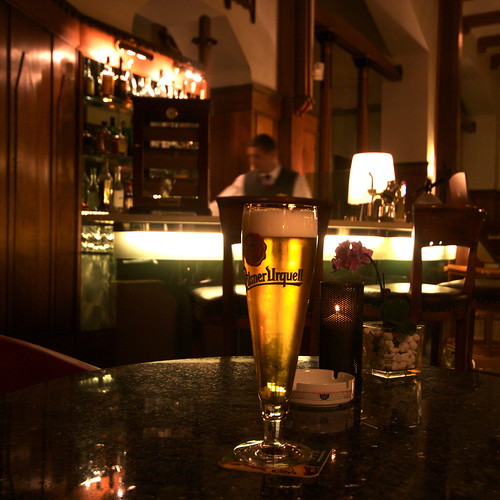One of the «new» Czech proverb says «Beer models beautiful bodies,» and it supposedly can see there everywhere.

Photography by Adrian Eden
In any case, the beer drinking culture are deeply rooted in Czech society. The first manual processing of Czech beers eighteenth century, and its author, Frantisek Ondrej Poupe also highly influential in the brewing industry to institutionalize the use of thermometers and other measuring instruments in the process. During socialism, going to bars was one of the few leisure activities legally permitted, so no wonder the power and prestige gained by the brewing industry in the country.
After the peaceful separation of Czechoslovakia in 1993, the Czech Republic was leading the world ranking of per capita beer consumption (many Slovaks prefer wine.) In 1995, Czechs drank an average of 161 liters per person. This would be a bottle of beer every day for every man, woman and child.

Photography by robertpaulyoung
There is a Czech urban legend helps you stay on top of the podium. Says that drinking beer makes you live longer, because it reduces the aluminum in the body, delaying the effects of aging and Alzheimer’s.
Where does it consume so much beer?
Czechs prefer to drink beer in pubs rather than at home. It’s all a social act, which meets to discuss anything, whether football, ice hockey, politics or women. It is usual to consume beer, no less than a pint per jar. The beer consumed is the blonde, 10 or 12 degrees, but the black, something softer, is currently cutting field. It is also very common consume bottled beers, while the cans are not well established and are designed primarily to tourism.
What is the best Czech beer?
The quality of Czech beer is legendary, but what is the best among them? There is no clear winner, but data can give us clues. Radgast has won the tender to the best Czech beer three times in succession. Kozel Velkopopovicky won in 1995. Plzensky Prazdoj (Pilsner Urquell) is the best known. The Gambrinus is a very great prestige. Let it be as absurd competition, promoted as so many other purely commercial.
However, there is a brand that unites many of these beers. Pilsner is undoubtedly the method of construction of world’s most famous beers. Original of the city of Pilsen (Plzen), came into use when the brewery in the town developed in 1842 called Plzensky Prazdoj beer (Pilsner Urquell). It was a lager 10 or 12 degrees, with a distinctive smooth taste provided by the hops used in its preparation. And from there, to conquer the world. Today we find in the center of Plzen a beer museum, the oldest in the world. The museum also produces its own variant of Pilsen, in small quantities.

Photography by The Intrepid Traveler
And what is the most popular beer among the Czechs?
From a small survey of over 1200 adult Czechs emerged the following results: Plzensky Prazdroj (Pilsner Urquell), Gambrinus, Radegast, Velkopopovicky Kozel, Budvar, Staropramen and then dozens of beers from more limited distribution.
As shown, foreign competition brewing has little to do in the Czech Republic. The prices of foreign brands are too high for the average Czech, who sees no reason to pay more for a beer of poor quality generally. In addition, the Czechs are very loyal to their products. As a result of all this, the penetration of foreign brands has been a pyrrhic 1%.
Some tips:
– If you visit the Czech Republic (Prague usually) do not deprive yourself to try the different varieties of beer. The prices are very cheap, about 50 cents a pint of beer you great.
– The best temperature to consume the beer is between 7 and 10 degrees Celsius.
– If you buy bottled beer, look at the light. Should be free of floating deposits.
– Before you drive you home, go to the brands of beer that you drink. You should not have forgotten to take the beer Gambrinus in any way.
Beer in the Czech Republic is quality!
Leave a Reply
You must be logged in to post a comment.
Recent Comments